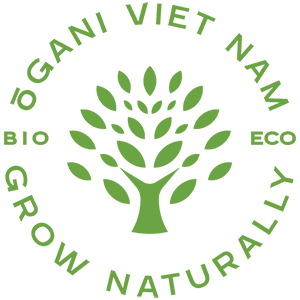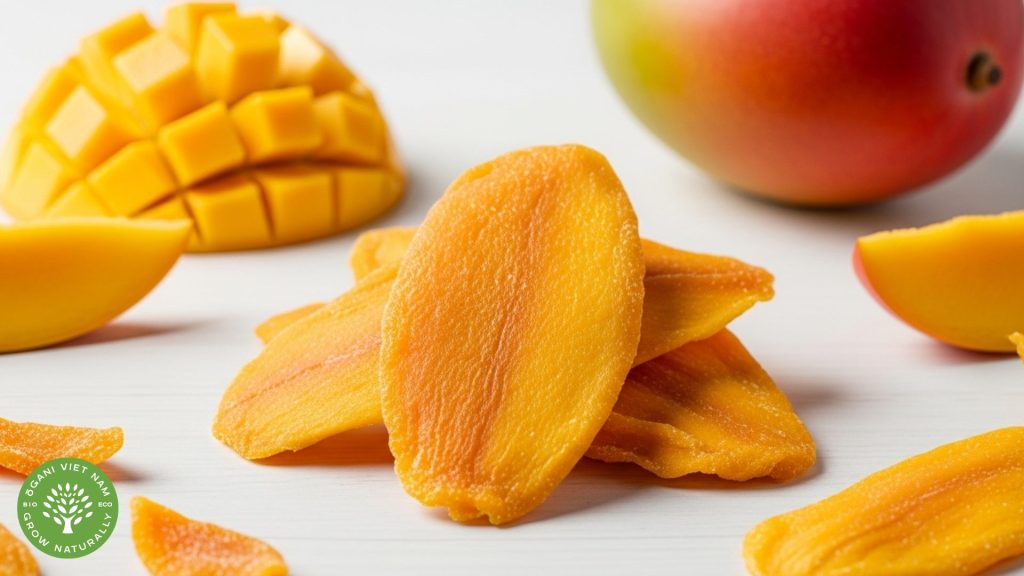
Sweet dried mango is more than just a snack – it’s a little taste of sunshine in every bite. At Ogani VN, we believe the best dried mango comes from letting the fruit speak for itself: the natural sweetness of ripe mangoes and the gentle drying process that keeps all the flavor inside.
When you chew on a slice of good dried mango, it feels like you’re tasting the warmth of tropical orchards. The sweetness becomes richer, almost like nature’s own candy – simple, pure, and impossible to resist. But remember, not every dried mango is the same. Some are loaded with extra sugar, while the real ones, like ours, let the fruit’s true flavor shine.
What makes dried mango naturally sweet
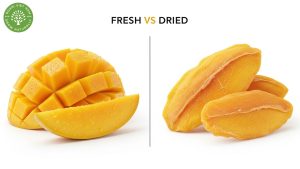
The sweetness of dried mango doesn’t come out of nowhere – it’s the magic of nature. When fresh mango loses water during drying, all the natural sugars like fructose and glucose become more concentrated, turning each slice into a chewy, golden treat that feels almost like candy.
Fresh ripe mango usually has about 13–15% natural sugar, but once dried, that number can rise to 60–70%. This explains why real sweet dried mango tastes so rich and satisfying without needing any added sugar.
Of course, not all dried mango is the same. Some brands add extra sweeteners, but the best ones let the fruit speak for itself. Varieties like Ataulfo, Kent, or the famous Philippine Carabao mango are naturally sweeter and more fragrant. That’s why at Ogani VN, we only choose mangoes that are allowed to ripen fully on the tree before being gently dried – so you can taste their full, natural sweetness.
Even the drying process matters. Slow dehydration at a lower temperature keeps more of the fruit’s enzymes and natural sugars intact. The result? A lively, fruity sweetness that feels authentic – not the flat, overly processed taste you sometimes get elsewhere.
Health benefits of sweet dried mango
Even though dried mango sweet tastes like candy, it’s actually full of goodness for your body. Just one small handful (about 1 ounce) can give you around 20% of the vitamin A and 15% of the vitamin C you need each day. Drying doesn’t take away the nutrients – it concentrates them, making dried mango a shelf-friendly super snack.
Each serving also has 1–2 grams of fiber, which is great for digestion and helps your body absorb sugar more slowly. You’ll also find about 180mg of potassium in every ounce, supporting a healthy heart and strong muscles.
On top of that, dried ripe mango is rich in antioxidants like beta-carotene – the same compound that gives mango its bright orange glow. These antioxidants protect your cells and boost your immune system, while mangiferin, a unique compound found in mangoes, has even been studied for its anti-inflammatory benefits.
Of course, balance is key. Since dried mango is calorie-dense (around 80–90 calories per ounce), it’s best enjoyed mindfully – as a natural treat, not a whole-bag binge.
And here’s something special: properly dried mango still keeps some of its natural enzymes, which can help with digestion. That’s something you won’t find in heavily processed sweets – making sweet dried mango not just tasty, but truly nourishing.
Best brands and where to buy quality sweet dried mango
Finding truly good dried mango sweet isn’t always easy – it depends on which brands really care about quality, not just mass production. After trying so many, we’ve found a few that never disappoint.
One of them is Mariani’s Thailand Premium Dried Mango. The slices are chewy in just the right way, naturally sweet, and made from carefully grown Thai mangoes. With so many happy customers (and almost a perfect rating), it’s clear they’ve mastered the balance of flavor and quality.
If you’re looking for something organic, Trader Joe’s Organic Dried Mango is another gem. No sulfites, no added sugar – just pure mango. Grown in the Philippines, it has that irresistible mix of sweetness with a little tang, making each bite fresh and addictive.
| Brand | Country of Origin | Added Sugar | Price Range | Our Rating |
|---|---|---|---|---|
| Mariani | Thailand | Minimal | $8-12/6oz | 9/10 |
| Trader Joe’s Organic | Philippines | None | $4-6/6oz | 8/10 |
| Sun-Maid | Various | Yes | $5-8/6oz | 7/10 |
| Kirkland (Costco) | Philippines | Yes | $12-15/35oz | 6/10 |
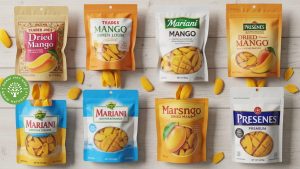
We’ve found that dried ripe mango from smaller, specialty brands often tastes far better than mass-produced options. For example, Mavuno Harvest works with organic farms in Africa, and their mango has an impressive depth of flavor. The packs may be a bit pricey, but once you taste them, you’ll understand why.
Here at Ogani VN, we take pride in bringing you the same level of care and quality – but with the unique taste of Vietnam. Our mangoes are grown in the lush Mekong Delta, where the tropical sun and fertile soil give them a natural sweetness like no other. By using a gentle sun-drying process, we keep that authentic flavor alive – the same flavor generations of locals have loved.
For bigger packs, brands like Costco’s Kirkland can be convenient, though the quality isn’t always consistent. If you go that route, it’s worth checking the label carefully to avoid too much added sugar or artificial ingredients. Nothing compares to the real, natural sweetness of properly dried mango.
How to make sweet dried mango at home
Making your own dried mango sweet at home is easier than you might think – and the best part is, you get to control everything: from how ripe the fruit is to how sweet you want it to taste. All you really need are some juicy mangoes, a little time, and a simple way to dry them. The result? A homemade treat that’s pure, healthy, and made just the way you like it.
Selecting the right mangoes
When making your own sweet dried mango, the secret starts with choosing the right fruit. Pick mangoes that are ripe but still firm – soft enough to give a little when pressed, but not mushy. Varieties like Ataulfo (often called honey mango) or Kent are perfect because they’re naturally sweet and less fibrous, which makes for smoother, tastier slices.
A little tip we’ve discovered: mangoes picked just slightly underripe and left to ripen at room temperature often dry better than those ripened fully on the tree. They stay firm enough to slice neatly, while still developing that rich, natural sweetness once dried.
Preparation and slicing
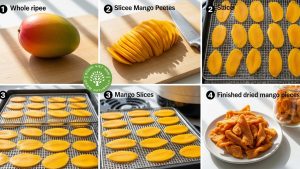
Start by washing your mangoes well, then peel them with a sharp knife or vegetable peeler. Slice the fruit into even pieces, about ¼ inch thick, so they dry at the same pace. You can go for long strips or smaller chunks – it really depends on the texture you like best.
If you enjoy a more candy-like dried mango sweet, try giving the slices a light honey glaze. Just mix 2 tablespoons of honey with 1 tablespoon of lemon juice, then brush it gently over the mango before drying. It adds a glossy finish and an extra layer of sweetness that makes each bite irresistible.
Drying methods
Using a dehydrator: Lay the mango slices on the trays, making sure they don’t overlap. Set the heat to around 135°F and let them dry for 8–12 hours. The result is usually very even, giving you that classic chewy sweet dried mango texture.
Using an oven: Line a baking sheet with parchment paper and arrange the slices in a single layer. Set your oven to the lowest temperature (usually 170–200°F) and leave the door slightly open so moisture can escape. Drying takes about 6–10 hours, and you’ll want to check in now and then to make sure they don’t get too dry.
When ready, your dried ripe mango should be bendy and a little sticky to the touch, but not wet. Store them in airtight containers and they’ll keep their flavor for months – though honestly, they’re so good they rarely last that long.
Frequently Asked Questions
Is dried mango naturally sweet enough without added sugar?
Yes! When mangoes are dried at their peak ripeness, all the natural sugars concentrate, creating that intense sweetness we love. Good-quality dried mango sweet doesn’t need any extra sugar – the fruit itself is more than enough.
How much dried mango is safe to eat daily?
About 1–2 ounces (roughly a small handful) is a healthy amount. This way you still get the vitamins, fiber, and antioxidants, while keeping calories and natural sugars in check.
Does dried mango keep the same nutrients as fresh mango?
Mostly, yes. While some vitamin C is lost in the drying process, most of the vitamins, minerals, and fiber stay intact. In fact, nutrients like fiber and antioxidants are even more concentrated per bite.
Why does some dried mango taste overly sweet or artificial?
That usually means sugar or syrup has been added. Always check the label – the best sweet dried mango should list just mango (and maybe a natural preservative), nothing else.
Can diabetics eat dried mango?
Yes, but only in moderation. Because the sugars are concentrated, portion control is very important. It’s best for diabetics to enjoy a small serving and talk with their healthcare provider about what fits their diet.
Ready to taste the sweetest dried mango ?
Dried mango sweet is one of nature’s simplest yet most perfect snacks – as long as it’s made with care. Whether you’re choosing a trusted brand or making it yourself at home, the secret is always the same: letting the fruit’s own natural sweetness shine, without covering it up with additives.
At Ogani VN, we’re proud to share Vietnam’s mango heritage with the world. Each pack of our sweet dried mango is made from carefully chosen fruit, ripened under the tropical sun and gently dried to keep its authentic flavor. It’s a wholesome treat that fits beautifully into a healthy lifestyle – sweet, simple, and full of sunshine.
Ready to taste the difference? Explore our collection of premium Vietnamese dried ripe mango and see why so many people fall in love with its natural flavor. Whether for yourself, as a thoughtful gift, or in bulk for your business, Ogani dried mango brings a piece of tropical paradise to every bite.
Read more:
- Wholesale Dealers Organic: Your Trusted Source at Ogani VN
- Dried Pineapple No Sugar Added: Healthy Snack by Ogani VN
- Dragon Fruit Powder: Unlocking Ít Superfood Potential for Health and Wellness.
- Dried Mango Benefits: 7 Amazing Health Reasons To Include This Superfruit In Your Diet
- Dried Mango Sweet: The Ultimate Guide To Nature’s Candy
